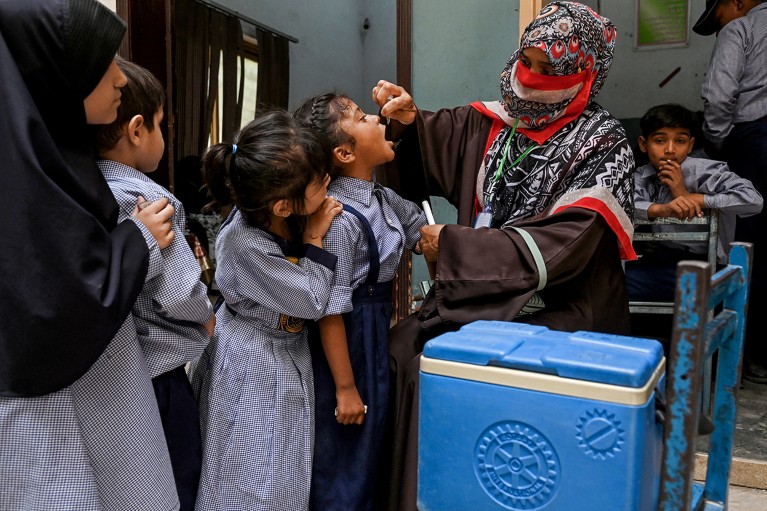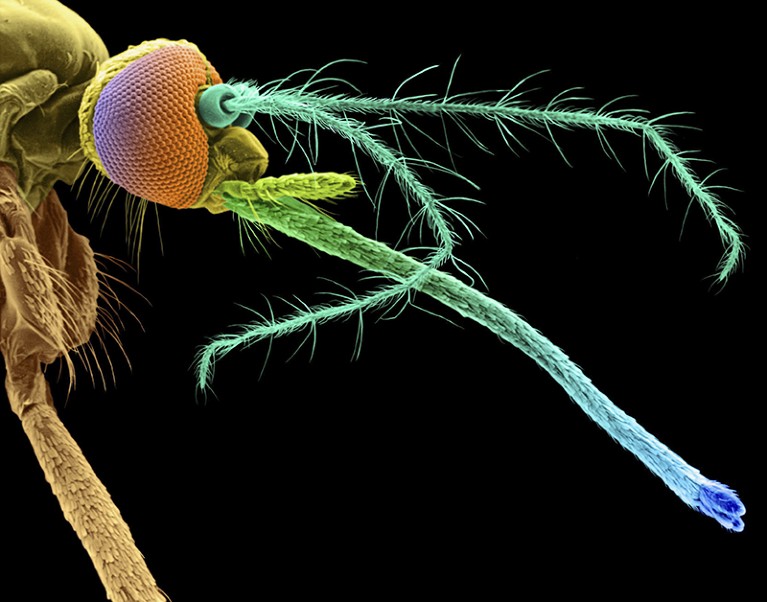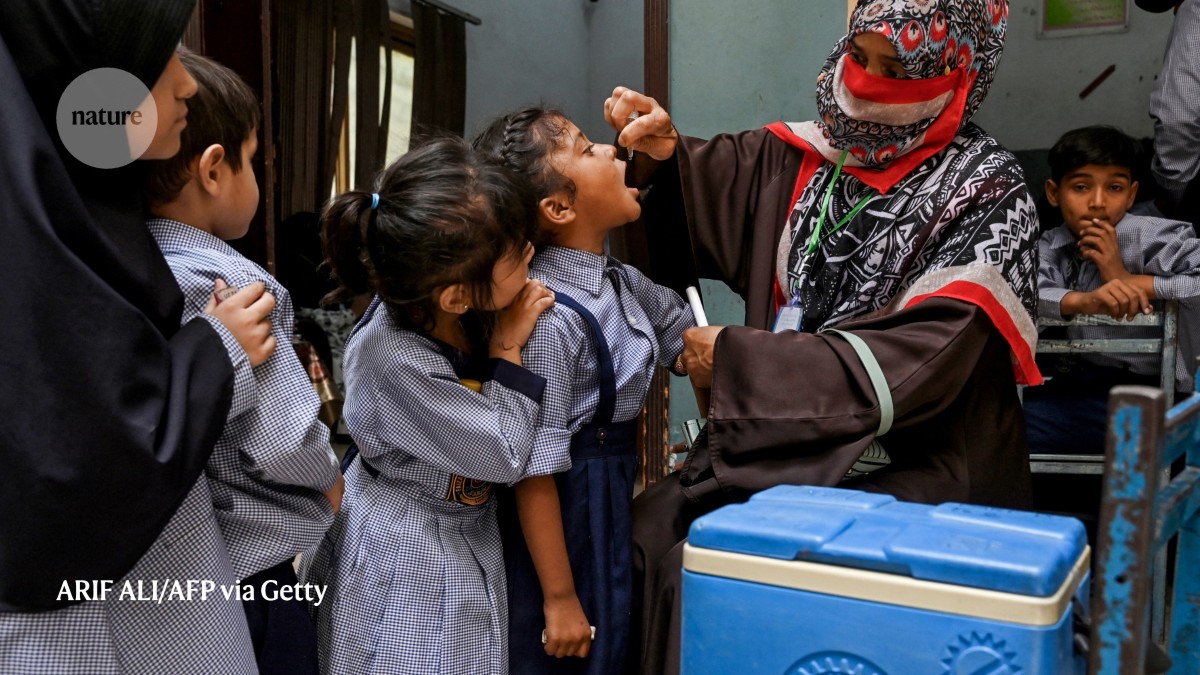
Children receive polio drops for vaccination during a door-to-door poliovirus eradication campaign in Lahore, Pakistan, in April.Credit: ARIF ALI/AFP via Getty
Vaccines are arguably one of the greatest inventions. Since 1974, global immunization efforts have saved the lives of some 154 million people — two-thirds of whom were infants — according to a paper published by The Lancet1 last year. Over the 50-year study period, vaccination accounted for a 40% decline in global infant mortality. And yet, around the world, these efforts are under threat.
The number of children who are missing routine vaccinations is increasing, especially in areas where conflict has disrupted basic health services. Funding cuts are taking a toll on public-health measures, including immunizations. Vaccine hesitancy — named one of the top ten threats to public health by the World Health Organization (WHO) in 2019 — is also driving deadly gaps in coverage. And with the withdrawal of US support from the WHO and Gavi, a Geneva-based global health charity that vaccinates children in lower-income countries, researchers worry that infectious-disease prevention will get worse before it gets better.
Here are four infectious diseases with rising case numbers, despite decades of vaccine development and use.
MEASLES: Revealing weaknesses
Measles is one of the world’s most contagious viruses. “It’s an infection that really identifies weaknesses in immunization programmes,” says William Moss, an infectious-disease epidemiologist at Johns Hopkins University in Baltimore, Maryland.
Nature Index 2025 Immunology
Two doses of the measles vaccine provide lifelong protection to 99% of people, says David Durrheim, a public-health physician and vaccinologist at the University of Newcastle in New South Wales, Australia. But because measles is so infectious, about 95% coverage with two doses of the vaccine is needed in all communities to achieve herd-immunity— the percentage of people who need to be immune to stop a disease from spreading. Despite the vaccine’s effectiveness — accounting for 94 million of the 154 million lives saved by immunization, according to the Lancet study — the global coverage rate is only 83% for the first dose and 74% for the second dose. As a result, measles kills more than 100,000 people a year, mostly children in low- to middle-income countries.
And infections are rising. Between 2022 and 2023, measles cases jumped by 20% to an estimated 10.3 million globally. Much of that increase was due to a slow-down in vaccination rates, made worse by the COVID-19 pandemic, Durrheim says. In the United States, measles was declared eliminated in 2000 by the WHO, yet in July this year, cases hit a high not seen since 1992. As of 30th September, 1,523 measles infections were confirmed across 42 US jurisdictions. Of those infected, 92% were unvaccinated or were of unknown vaccination status.
An increase in anti-vaccine sentiment, especially in the United States, is a major factor in immunity gaps, says Erica Ollmann Saphire, president and chief executive of the La Jolla Institute for Immunology in San Diego, California. In a study published in June2, researchers found that 78% of more than 2,000 US counties reported declines in measles vaccination. The average vaccination rate fell from almost 94% before the pandemic to 91% after it, well below the 95% herd-immunity threshold.
At the same time, there is a growing number of immunocompromised people who cannot receive the measles vaccine, Saphire says. According to a study published last year3, the proportion of US adults who are immunocompromised has more than doubled, from 2.7% in 2013 to 6.6% in 2021. The authors suggest that an increase in the use of immune-suppressing drugs such as adalimumab, prescribed for arthritis and other conditions, and more people living longer with diseases that weaken immunity, such as cancer and HIV, could be behind the surge. “There are more vulnerable people right when our walls of defence are crumbling,” says Saphire.
Not only is measles an unpleasant and potentially dangerous disease, but the virus has an additional effect on the immune system, causing it to forget previously encountered infections and how to deal with them. “The complications from measles are not trivial — it’s a nasty disease,” says Rafi Ahmed, an immunologist at Emory University in Atlanta, Georgia. “Kids are sick for a long time, and they get immunosuppressed for several months, making them susceptible to other infections.”
There is no specific treatment for measles. Saphire and her colleagues are working on a new therapy that uses antibodies (proteins produced by the immune system) to stop the virus from attaching to cells or changing shape to enter them. The work began with a 2024 Science4 paper outlining what Saphire describes as the first detailed structure of a mouse antibody bound to the surface protein of a measles virus. They have since done a similar study5 on fully human antibodies that could be used in future treatments, she says, which they expect to publish in the coming months.
The team is also developing a vaccine that does not use live virus, which could be safer for immunocompromised people. But Saphire says they are struggling to secure funding to advance their work. This is surprising and disappointing, she says, “because we’re in the middle of an outbreak”.
POLIO: State of stalemate
In 1988, the World Health Assembly — the decision-making body of the WHO — set a lofty but seemingly achievable goal: eradication of polio by the year 2000. “The original anticipation was that global eradication would go quite quickly,” says Peter Wright, a paediatrician and infectious-disease researcher at Dartmouth College in Hanover, New Hampshire. But although numbers have greatly declined as a result of immunization campaigns and increasing routine vaccine coverage, the global community is in a stalemate with polio, he says.
Poliovirus mainly infects the gut, where it replicates and enters the bloodstream. In a small number of cases, it invades motor neurons in the central nervous system, causing paralysis. Naturally occurring strains of the virus are endemic in two countries, Afghanistan and Pakistan, where vaccination rates are lower than in other places. Cases have remained low but persistent for decades, and are now creeping up, from 12 in 2023 to 99 in 2024.
Declining vaccination rates are also an issue in countries where the naturally occurring strains have been eradicated. Mutations of the weakened virus used in the oral polio vaccine can behave like wild poliovirus and cause outbreaks, says Wright. After being shed into the environment through a vaccinated child’s faeces, it can infect unvaccinated children in places where sanitation is poor. Circulating vaccine-derived poliovirus, as it is known, now infects several hundred children each year in around 30 countries, mostly in Africa. Last year, Gaza reported its first case of vaccine-derived polio in 25 years6, due to the collapse of health-care and sanitation systems amid the ongoing conflict with Israel.
In 2011, a large group of research institutions, global health bodies and governments came together to develop a more stable oral vaccine to control outbreaks of vaccine-derived poliovirus. The new vaccine has been in use since 2021. But in areas with low vaccination coverage, it can still mutate and spread, just like the original oral vaccine. “The only permanent solution to preventing vaccine-derived polio outbreaks is to exclusively use inactivated, injectable polio vaccines,” says Durrheim, referring to a different type of vaccination that countries such as the United States and Australia use, which does not use live virus. It is more expensive to produce than the oral vaccine, however, and requires trained health-care workers to administer, which limits its use in low-income settings. According to Durrheim, “we’ve got the means to eradicate polio; we just need to do it well.”
Meanwhile, commitment to the goal of polio eradication is waning, including among some important donors. “I think everybody is tired, and the amount of money to continue [the effort] is of concern,” Wright says. The United States’ withdrawal of support for global immunization programmes — including for polio — earlier this year by shuttering the United States Agency for International Development (USAID) and terminating funding for Gavi is especially concerning, adds Walter Orenstein, a global public health scientist at Emory University.
The US Centers for Disease Control and Prevention (CDC) has been a major funder of polio eradication efforts, but it also faces cuts to its global vaccination programmes. Without continued and sustained effort, global cases will go up, including in the United States, says Orenstein. In 2022, the New York Department of Health confirmed a case of paralytic polio — the first in the United States in 30 years. “Supporting polio eradication is a win–win situation,” Orenstein says. “It not only protects people in those countries, but also in our own.”
YELLOW FEVER: Vigilance vital
Yellow fever is vaccine-preventable, but because the virus circulates between mosquitoes and non-human primates, it can’t be eradicated. The goal is to control its spread. In 2023, more than 62 million vaccine doses were administered in Africa, where the disease occurs naturally. “The vaccine lasts forever, so if you get it for your young population, you’re protecting the future generation,” says Oyewale Tomori, a virologist at Redeemer’s University in Ede, Nigeria. “But the rate of vaccination is not encouraging in many African countries.”

Yellow fever is largely spread by the mosquito Aedes aegypti.Credit: Dennish Kunkel Microscopy/Science Photo Library
In 2025, cases in the Americas increased more than eightfold compared with the same time in 2024, according to the Pan American Health Organization (PAHO), an international public-health agency for the Americas and regional office for the WHO. As of September, 334 cases were confirmed in six countries in South America, including 141 deaths. According to PAHO, almost all cases occurred in unvaccinated people in areas in and around forests where animals carry the disease. “People who go into the bush can bring [yellow fever] into urban centres,” says Tomori.
The yellow fever virus multiplies in immune cells inside the lymph nodes before spreading to other parts of the body. If the virus reaches the liver or kidneys, for example, it can cause serious damage and impair the organ’s function. There is no treatment for yellow fever, so supportive care is the only option, says Erin Staples, a medical epidemiologist at the CDC. Most people who are infected are asymptomatic; of those who do develop symptoms, 33% have mild cases and 12% have severe ones. Those who develop severe disease have an almost 50% risk of death.
Global yellow fever activity typically peaks every ten years or so in endemic areas, which is probably connected to fluctuating immunity in human populations, says Tomori. Climate change could increase mosquito breeding in some areas because of altered rainfall patterns, Moss adds, which might expand the disease’s reach as temperatures rise. Excessive heat and drought, on the other hand, could reduce mosquito populations in some locations, says Tomori.



